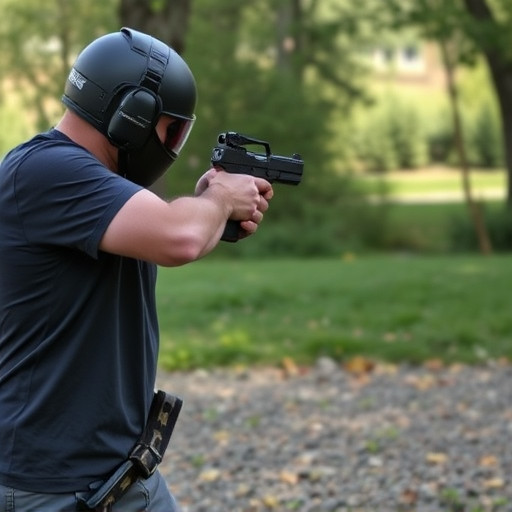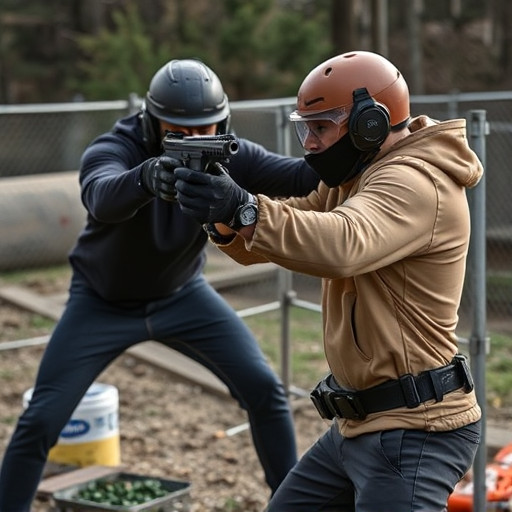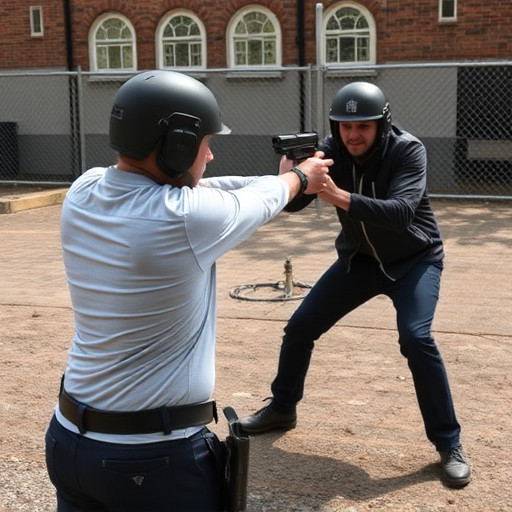Police-Grade Stun Guns: Optimizing Electrode Spacing for Maximum Effectiveness
Police-grade stun guns prioritize strategic electrode spacing for maximum effectiveness, balancing p…….
Police-grade stun guns prioritize strategic electrode spacing for maximum effectiveness, balancing power and usability. Their advanced design ensures efficient current distribution for quicker, safer incapacitation of targets, crucial in diverse scenarios from law enforcement to personal defense. Future developments aim to enhance portability, convenience, and user safety through intelligent design featuring smart sensors, GPS tracking, and wireless charging. Choosing the right Police Grade Stun Gun Option involves considering electrode configuration and power output for optimal impact against various adversaries.
Discover the intricate world of stun gun electrode spacing, a critical factor in their effectiveness. This article explores the science behind this often-overlooked aspect, delving into how ‘Police Grade Stun Guns’ differentiate themselves through advanced design. We analyze factors influencing electrode spacing, offering insights to optimize performance. From real-world applications to future technology trends, learn how these devices enhance personal safety. Uncover the key differences between various police-grade stun gun options and understand why precise electrode spacing matters for maximum impact.
- Understanding Stun Gun Electrode Spacing: The Basic Concept
- Police Grade Stun Guns: What Makes Them Different?
- Factors Influencing Electrode Spacing Effectiveness
- Optimizing Stun Gun Performance Through Electrodes
- Real-World Applications and Case Studies
- Future Trends in Stun Gun Technology for Enhanced Safety
Understanding Stun Gun Electrode Spacing: The Basic Concept

Stun gun electrode spacing refers to the distance between the two electrodes on a stun device, a critical factor in its effectiveness. The concept is straightforward: closer spacing allows for better electrical conductivity, ensuring a more powerful and efficient shock. This is particularly important in self-defense scenarios where speed and impact are paramount. Police-grade stun guns, known for their reliability and strength, often feature strategic electrode placement to maximize stun potential.
Understanding this basic principle becomes crucial when considering different Police Grade Stun Gun Options available in the market. Manufacturers carefully design these devices with specific electrode spacing to balance power, weight, and usability. By choosing a stun gun with appropriately spaced electrodes, users can ensure they have a reliable tool for personal safety without sacrificing portability or ease of use.
Police Grade Stun Guns: What Makes Them Different?

Police-grade stun guns are designed with a specific purpose in mind: to incapacitate an assailant temporarily, giving the user time to escape or for backup to arrive. These devices operate on a principle of delivering electrical impulses that disrupt muscle control, resulting in temporary paralysis. What sets them apart from consumer-grade options is their robustness and reliability under extreme conditions. Police grade stun guns are built to withstand harsh environments, including intense heat and cold, making them a preferred choice for officers who need a consistent and dependable tool in high-pressure situations.
The electrode spacing in these stun guns is a critical factor for effectiveness. Unlike regular stun devices, which may have varying electrode configurations, police-grade models often feature optimized arrangements to ensure maximum current flow and optimal shock distribution. This precision engineering allows for more precise control over the target area, enhancing the stun gun’s overall performance. Additionally, these weapons are designed with safety features, such as automated shut-off mechanisms, ensuring they remain a reliable tool for law enforcement professionals.
Factors Influencing Electrode Spacing Effectiveness

The effectiveness of a stun gun’s electrode spacing is influenced by several key factors, particularly when considering Police Grade Stun Gun options. One critical aspect is the distance between the electrodes; this determines the stun gun’s range and power. Closer electrode spacing provides higher current density, ensuring a stronger electric discharge that can incapacitate targets more efficiently. However, excessive proximity might cause arcing, reducing the device’s effectiveness and potentially damaging the equipment.
Another influencing factor is the size and shape of the electrodes. Larger electrode surfaces increase contact area with the target, allowing for better conduction of electricity. Additionally, unique electrode designs or materials can enhance energy distribution, making the stun gun more versatile and effective in various scenarios. When choosing a police-grade stun gun, understanding these factors ensures users get the most out of their equipment, maximizing its effectiveness in real-world applications.
Optimizing Stun Gun Performance Through Electrodes

Optimizing stun gun performance through electrode spacing and design is crucial, especially for police-grade options where every second counts. The effectiveness of a stun gun relies heavily on the strategic placement of electrodes. These electrical terminals deliver a powerful jolt when activated, temporarily neutralizing a target. Well-designed electrodes ensure that the current flows efficiently through the body, incapacitating the subject quickly and safely.
Police-grade stun guns often feature advanced electrode systems, allowing for precise control over the intensity and distribution of the electric shock. The spacing between these electrodes plays a significant role in maximizing the impact. Closer electrode spacing can increase the concentration of the electric field, resulting in faster muscle contractions and a more powerful stun. However, proper balancing is essential to avoid excessive current density, which could lead to adverse effects on the target’s health.
Real-World Applications and Case Studies

In real-world applications, Police Grade Stun Guns have proven their effectiveness in various scenarios, from law enforcement to personal defense. These devices are designed to disrupt an attacker’s motor functions, providing individuals with a powerful non-lethal option for self-defense. Case studies show that proper electrode spacing is crucial for optimal performance. Modern stun guns often feature advanced electrode designs, ensuring precise current distribution and increased effectiveness at close range—a critical factor in high-stress situations.
The selection of the right Police Grade Stun Gun Option involves considering not just power output but also electrode configuration. Well-spaced electrodes allow for better contact with the attacker’s body, maximizing the stun gun’s impact. This is particularly important when dealing with larger or more agile targets, where precise placement and spacing can significantly enhance the device’s effectiveness in neutralizing an assailant without causing severe injury.
Future Trends in Stun Gun Technology for Enhanced Safety

As technology advances, so does the evolution of stun gun design and safety features. Future trends in stun gun technology aim to enhance effectiveness, convenience, and user safety. One notable development is the integration of advanced materials and miniaturization, leading to more compact and lightweight devices without sacrificing power. These innovations make stun guns easier for individuals to carry and deploy in various situations.
Additionally, there’s a growing focus on intelligent design and connectivity. Some Police Grade Stun Gun Options now incorporate smart sensors and GPS tracking, allowing users to monitor device status and locate them if lost or stolen. This enhances personal safety and security. Moreover, wireless charging capabilities are becoming more common, providing convenience and extending the lifespan of the device’s battery. These future trends demonstrate a commitment to making stun guns more accessible, reliable, and user-friendly, ensuring individuals have an extra layer of protection in potential dangerous scenarios.
The optimal electrode spacing in stun guns plays a pivotal role in their effectiveness. Understanding how factors like current density and target area interact ensures users can make informed choices among available police grade stun gun options. Future advancements in stun gun technology, focusing on precise electrode placement and enhanced safety features, promise to further improve their reliability and impact, making them crucial tools for personal and public safety alike.


